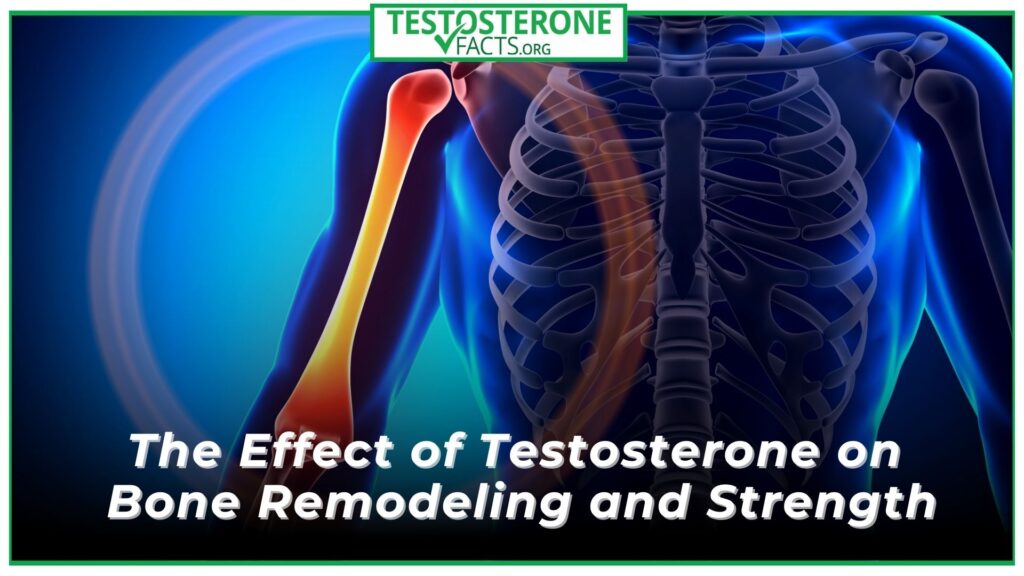
The Effect of Testosterone on Bone Remodeling and Strength
- TFacts Staff

Testosterone is a steroid male sex hormone. It is mostly produced in the testes of males and smaller amounts in the ovaries of females. It is essential for several physiological functions. It helps in fat distribution, sex function, and muscular growth. It has significant effect on bone health, especially with regard to bone remodeling and strength.
Understanding the impact of testosterone on bone remodeling is crucial in tackling concerns associated to bone density, osteoporosis, and general skeletal integrity, particularly in the elderly population.
Table of Contents
ToggleOverview of Bone Remodeling
In bone remodeling, osteoblasts produce new bone while osteoclasts remove aged bone tissue. It keeps the skeleton strong and fixes small wounds. It is affected by hormones like estrogen and testosterone, diet, and mechanical stress. Estrogen and testosterone are needed for maintaining bone health. However testosterone is necessary for males while estrogen for women. These hormones work together to maintain overall skeletal integrity and balance bone density.
Testosterone and Bone Density
According to study, testosterone has a major impact on bone density because it promotes bone growth while preventing resorption. It protects against resorption indirectly by converting to estrogen. This inhibits osteoclasts and increases osteoblast activity in males. As a result new bones are formed in the body. Testosterone also helps maintain bone density in women as well. Therefore, osteoporosis risk is higher in postmenopausal women due to hormone reductions.
Testosterone and the Process of Bone Remodeling
Testosterone affects bone remodeling by multiple mechanisms. It is essential for maintaining the equilibrium between bone creation and resorption. This is because it promotes the differentiation of precursor cells into mature osteoblasts.
Furthermore, testosterone increases bone strength, especially in males who usually have higher bone densities. Testosterone encourages the deposition of calcium and phosphate and improves the mineralization of bone tissue. Testosterone also plays a critical function in maintaining the general health of bones by inhibiting osteoclast activity and preventing bone loss.
The Impact of Aging on Testosterone and Bone Health
Since testosterone levels decrease with age, aging has a substantial impact on testosterone’s function in bone health. It happens especially in males. This reduction is associated with a slow loss of bone mineral density, raising the possibility of fractures and osteoporosis, particularly in the wrist, hip, and spine. This age-related transition is frequently referred to as “andropause”.
Bone resorption may exceed formation when testosterone levels decline. It leads to a loss of bone density. Estrogen is the main hormone influencing bone health in women. However, decreasing testosterone in women also plays a role in bone loss. This happens particularly after menopause. Thus, both hormones are essential in females to keep the bones strong.
Testosterone Replacement Therapy (TRT) and Bone Health
One effective treatment for males with low testosterone levels is testosterone replacement therapy (TRT). TRT is a procedure which can stop or reverse bone loss. It can lower the risk of fracture by increasing bone mineral density in the hip and lumbar spine. However, TRT is linked to a number of hazards, such as cardiovascular problems and concerns about the health of the prostate. Therefore decisions should only be taken after carefully weighing the advantages and disadvantages of each option.
Testosterone therapy is less prevalent in women since estrogen replacement treatment (ERT) is typically recommended for postmenopausal bone loss. However, women who are at risk of osteoporosis may consider testosterone therapy.
The Role of Lifestyle Factors in Testosterone and Bone Health
Although testosterone levels are a major component in determining bone health, lifestyle choices also have a big impact on how testosterone affects bone strength and remodeling. Promoting bone development and physical activities can improve bone density. Men’s testosterone levels have been demonstrated to rise with regular exercise, which has two benefits for bone health.
In addition, dietary components such as sufficient calcium, vitamin D, and protein intake are essential for preserving bone health and maximizing the benefits of testosterone on bone health. Specifically, deficiencies in vitamin D can worsen bone loss, even in those with normal testosterone levels. This vitamin is necessary for testosterone and bone health.
Conclusion
Testosterone and bone health are essential for bone formation and inhibiting bone resorption. Age-related decreases in testosterone levels raise the risk of osteoporosis and contribute to bone loss, especially in men. For men with low testosterone, testosterone replacement treatment may be able to preserve bone density, but there are hazards involved that should be carefully examined before using it.
The benefits of testosterone on bone health are further supported by lifestyle choices including diet and exercise. In order to ensure long-term skeletal health for both men and women, it is important to comprehend the relationship between testosterone and bone health and create measures to prevent and cure bone-related illnesses.
Frequently Asked Questions
1. How does testosterone affect bone remodeling?
Testosterone stimulates osteoblasts, which are cells that make new bone, and improves bone mineralization, which strengthens bone. These actions enhance bone remodeling. Additionally, by changing into estrogen and suppressing osteoclasts—cells that break down bone—it indirectly prevents bone resorption. Maintaining bone density and avoiding bone loss depend on this delicate balance between bone creation and resorption, which supports general skeletal health.
2. Can testosterone replacement therapy (TRT) improve bone health in men?
Yes, testosterone replacement therapy (TRT) can improve bone mineral density in men with low testosterone levels, particularly in areas prone to fractures like the spine and hip. By promoting bone formation and reducing bone loss, TRT helps reduce fracture risk. However, it comes with potential risks, including cardiovascular concerns, so its use should be carefully considered under medical guidance.
3. Does testosterone affect bone health in women?
Although it has less of an effect than estrogen, testosterone helps women’s bones stay strong. It supports the preservation of bone density, and osteoporosis is made more likely by the reductions in estrogen and testosterone that occur after menopause. Although estrogen therapy is more prevalent, testosterone therapy can occasionally be used in conjunction with estrogen replacement to improve bone health in women, especially those with low androgen levels.




